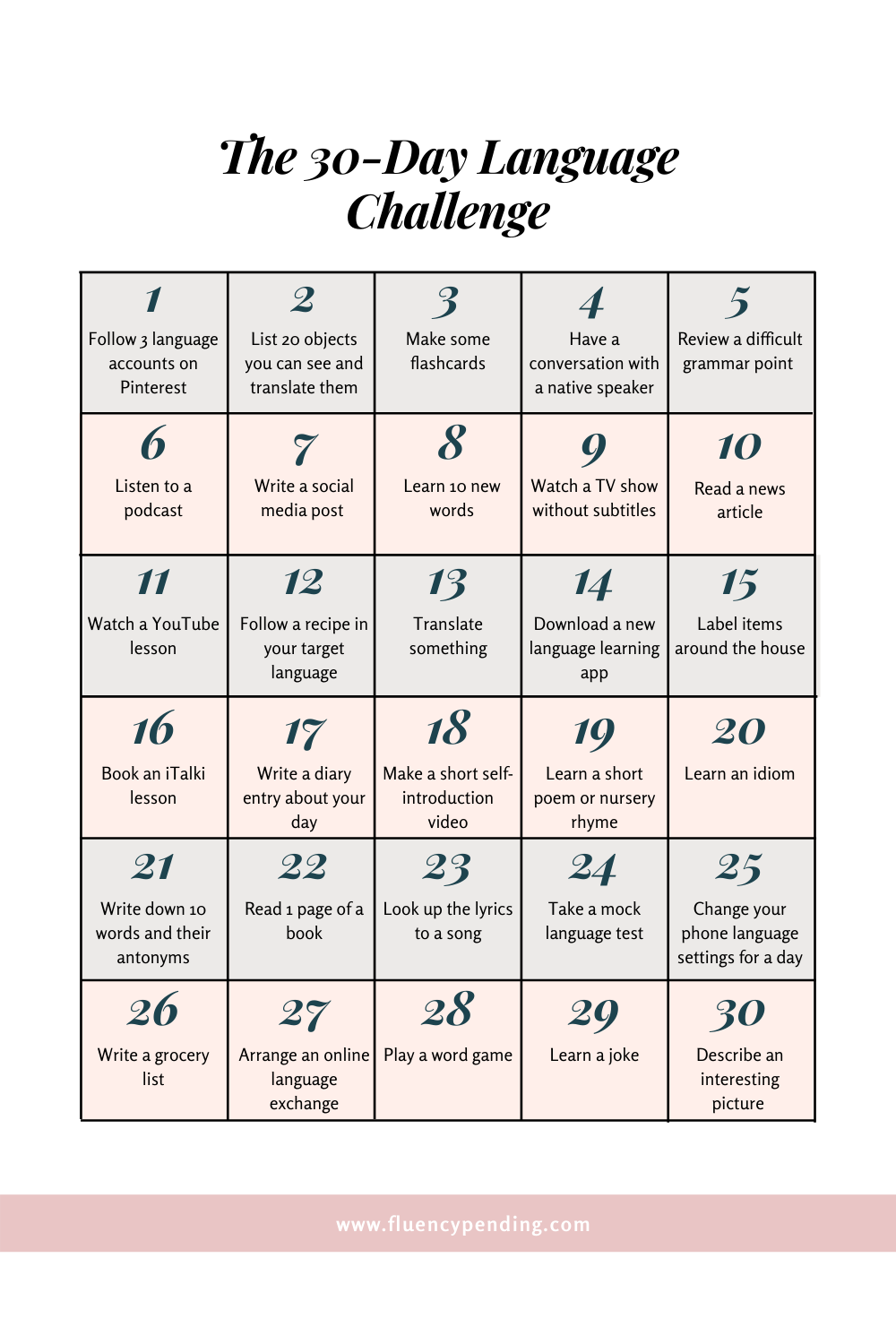
Take the 30-Day Language Challenge!
Please keep in mind that some of the links in this post are affiliate links. In the event of a sale, I will be awarded a small commission (at no extra cost for you). Thank you for supporting my blog!
Ready to kickstart your language learning? Take the 30-day language challenge!
The challenge is meant to be a fun guide, so if you find that some of the points don’t suit your objectives or target language, you can exchange it for something that makes more sense to you. Adapt it as you want, and have fun!
Day 1: Follow 3 language accounts on Pinterest
Pinterest is one of my favourite resources for language learning. You can find anything from vocabulary pins to language learning blog posts to useful infographics on just about any language.
Follow my language learning boards here.
Day 2: List 20 objects you can see and translate them
A useful way to mine new vocabulary for everyday items is to play ‘I Spy’ and write down objects you see and look up their translations. You’ll be surprised at how many new words you discover.
Day 3: Make some flashcards
Use a flashcard app like Anki or Quizlet or stick with good old pen and paper. But before you start working through your deck, read up on the best approach to using flashcards for language learning.
Day 4: Have a conversation with a native speaker
Talk to a friend, a neighbour or find a professional tutor to practice speaking with on an online platform like Rype.
If you are not ready to speak to someone else, try practicing speaking to yourself in the mirror.
Day 5: Review a difficult grammar point
Is there a grammar rule that just never quite stuck? Set aside some time today to master it once and for all.
Day 6: Listen to a podcast
Podcasts are great for when you’re on the go. Listen to a language learning podcast on your commute, while waiting in line or when exercising.
Day 7: Write a social media post
Write an Instagram caption or tweet in your target language.
Day 8: Learn 10 new words
Find the best techniques for learning new vocabulary here.
Day 9: Watch a TV show (without subtitles)
If the thought of going without subtitles stresses you out, just try to actively engage with the content, pausing often to jot down any vocabulary or grammar points to review later.
Day 10: Read a news article
Reading the news is a great way to pick up topical vocabulary. If your level is not advanced enough to read news articles with ease, look for graded news articles aimed at language learners.
Day 11: Watch a YouTube lesson
I love watching Chinese Zero to Hero’s HSK-based Mandarin lessons on YouTube.
Also read: 3 YouTubers to follow if you’re into language learning
Day 12: Follow a recipe in your target language
Start with something simple like making French toast or poaching an egg.
Day 13: Translate something
Take a paragraph from a book or news article in your target language and translate it as best you can.
Day 14: Download a new language learning app
There are so many great language learning apps out there. Try:
Day 15: Label items around the house
Another great way to learn the words for everyday items is to stick labels around the house. Make them yourself or buy these cute label sets on Amazon.
Day 16: Book an iTalki lesson
iTalki is an affordable way to connect with professional language teachers and community tutors online.
This challenge is just a guide, so if you do not want to spend any money on online tutoring, you absolutely don’t have to! Skip the day (rest is good, too!) or exchange it for something else, like working through a lesson in your textbook.
Day 17: Write a diary entry about your day
Journaling in your target language is a great way to start producing sentences of your own.
Find some writing prompts for your language journal here.
Day 18: Make a short self-introduction video
You don’t have to show your video to anyone if you are shy, but it is a good idea to get a trusted teacher or native speaking friend to take a look so they can help correct any mistakes.
Day 19: Learn a short poem or nursery rhyme in your target language
Children’s books like this one (in English and Chinese) are great for finding easy rhymes and poems.
Day 20: Learn an idiom
Getting to grips with idiomatic expressions in a new language can be tricky, but idioms are fun to learn and using them in speech will help you sound more sophisticated.
Day 21: Write down 10 words and their antonyms
This is a good way to expand your vocabulary using words you already know. You can also try looking up synonyms and other related words or phrases.
Day 22: Read one page of a book
Reading is one of the best ways to learn vocabulary in context. If you are a beginner, you can start out with children’s picture books or a familiar story (like The Little Prince) in translation.
Day 23: Look up the lyrics to a song
Music is a fun way to learn a new language. Here are some useful tips on learning a language through songs.
Day 24: Take a mock language test
Treat it as a real test and set a timer based on the time allocation of the test. Score your test and use your results to identify any weak points.
Day 25: Change your phone language settings for a day
We use our phones 96 times a day, so changing your phone language for a while is a great immersion exercise.
Day 26: Write a grocery list in your target language
Next time you go to the grocery store, write out your shopping list in your target language..
Day 27: Arrange an online language exchange
Not sure what to talk about with your language exchange partner? Check out these 100 conversation starters.
Day 28: Play a word game
Try word games like crosswords, word searches, word matching and Boggle or look for foreign language editions of classic games like Spanish Madlibs.
Day 29: Learn a joke
Impress your native friends by learning a funny joke in your target language.
Day 30: Describe an interesting picture
Find a picture from a magazine or online that interests you and try to describe it in your target language. This can be as simple as merely describing what you see (for example, ‘The girl is wearing a red dress’) to more complex thoughts (for example, building a fictional narrative around the image).
Are you joining the 30-Day Language Challenge? Let me know how you’re getting along in the comments below!







